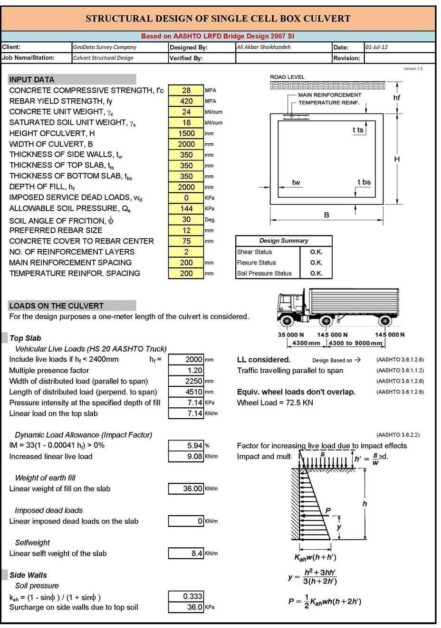Mike has a worksheet that contains some times. If he subtracts 6:33 from 6:21 he noticed that he doesn't get a negative elapsed time, as in -:12. Instead he gets ############# in the cell. Mike is wondering how he can display the negative time difference properly?
The easiest way to solve this problem is to just change the date system used by the workbook. This may sound goofy, but if you use a 1900 date system (which is the default for Windows versions of Excel), then you get the ############# in the cell. If, instead, you change to the 1904 date system (which is the default for Mac versions of Excel) then you'll see the correct negative elapsed time in your formula.
Crack Width Calc - BS 8110 - Free download as Excel Spreadsheet (.xls), PDF File (.pdf), Text File (.txt) or read online for free. Crack Width Calculation. Crack width calculation for (BS 8110 BS 8007) by The Concrete Center Reinforced Concrete Retaining Wall Design to BS 8110 by The Concrete Center Continuous Beam Analysis and Design to EC2 by Reinforced Concrete Council.
- The Bolted Joint Analysis calculator allows for stress analysis of a bolted joint, accounting for preload, applied axial load, and applied shear load.
- The crack width for lower values of concrete cover or grade of steel while the Indian standard as well as the other expressions under estimates it as shown in figure 5.1, 5.2, 5.3. Figure 5.1.1: Estimation of crack width using different formulas compared with expt. Data for 20 mm cover.
To change the date system, follow these steps:
- Display the Excel Options dialog box. (In Excel 2007 click the Office button and then click Excel Options. In Excel 2010 or a later version, display the File tab of the ribbon and then click Options.)
- Click Advanced at the left side of the dialog box.
- Scroll through the options until you see the section called When Calculating This Workbook. (See Figure 1.)
- The Use 1904 Date System check box controls which dating system is used, just as in earlier versions of Excel.
Figure 1. The Advanced options of the Excel Options dialog box.
If you prefer to not change the dating system used in the workbook (perhaps it may mess up some other date formulas you have in the worksheet), then the only thing you can do is to create a text-based version of the time differential using a formula such as the following:
If the difference between the two time values (in A2 and B2) is negative, then the formula concatenates a text value consisting of the minus sign and the absolute value of the difference between the times.
Eurocode 2 part 1-1: Design of concrete structures 7.3 Crack control
The crack width, wk, may be calculated as follows:
| wk = sr,max⋅(εsm - εcm) | (7.8) |
where:
- sr,max
- is the maximum crack spacing
- εsm
- is the mean strain in the reinforcement under the relevant combination of loads, including the effect of imposed deformations and taking into account the effects of tension stiffening
- εcm
- is the mean strain in the concrete between cracks.
| (7.9) |
where:
see application for a rectangular section or application for a T-section
 Ecm
Ecmwith
- Ecm
- the secant modulus of elasticity of concrete
fct,eff = fctm or lower, (fctm(t)), if cracking is expected earlier than 28 days
| = (As + ξ1⋅A'p)/Ac,eff | (7.10) |
with
Crack Width Calculation Spreadsheet

| ξ1 = | (7.5) |
with
- ξ
- the ratio of bond strength of prestressing and reinforcing steel, according to Table 6.2
- ΦS
- the largest bar diameter of the reinforcing steel
- ΦP
- the diameter or equivalent diameter of prestressing steel:
Φp = 1,6⋅√AP for bundles, where AP is the area of a prestressing steel,
Φp = 1,75⋅Φwire for single 7 wire strands,
Φp = 1,20⋅Φwire for single 3 wire strands, where Φwire is the wire diameter.
kt = 0,6 for short term loading,
kt = 0,4 for long term loading.
• Where the bonded reinforcenlent is fixed at reasonably close centres within the tension zone (spacing ≤ 5(c + Φ/2), cf. Figure 7.2), the maximum crack spacing sr,max may be calculated as follows:
| sr,max = k3c + k1k2k4Φ / ρp,eff | (7.11) |
where:
k1 = 0,8 for high bond bars,
k1 = 1,6 for bars with an effectively plain surface (e.g. prestressing tendons).
k2 = 0,5 for bending,
k2 = 1,0 for pure tension.
Intermediate values of k2 should be used for cases of eccentric tension or for local areas:
| k2 = (ε1 + ε2)/(2ε1) | (7.13) |
where ε1 is the greater and ε2 is the lesser tensile strain at the boundaries of the section considered, assessed on the basis of a cracked section.
• Where the spacing of the bonded reinforcement exceeds 5(c + Φ/2) (cf. Figure 7.2), or where there is no bonded reinforcement within the tension zone, the maximum crack spacing sr,max may be calculated as follows:
| sr,max = 1,3(h - x) | (7.14) |
where:
- h
- is the overall depth of the section (see Figure 7.1)
- x
- is the neutral axis depth of the section (see Figure 7.1).
This application calculates the crack width wk from your inputs. Intermediate results will also be given.
First, change the following option if necessary: